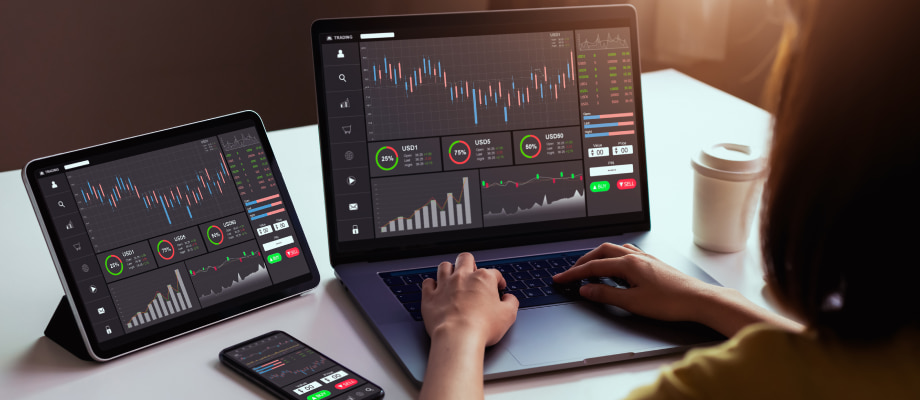A margin account is a specialised trading or investment account online brokers offer. This account allows investors to potentially amplify their investment gains by borrowing funds from their broker. While margin accounts offer increased opportunities, using them comes with additional risks. So, what are margin accounts, and how do you use them in your investment activities?
We have prepared this guide to explore the workings of a margin account. This is from understanding its basic concept to opening an account and trading on margin. In the end, you will have a comprehensive understanding of how a margin account operates and the factors to consider before using one in your investment strategy.
What Is a Margin Account?

A margin account is a financial investment or trading account that enables investors to borrow funds from their brokers to put up in a financial asset. Unlike a cash account, where you can only trade with the available funds in the account, a margin account allows you to leverage your buying power by using borrowed money. This way, you get to potentially increase your investment capacity beyond the amount of cash you have available.
Keep in mind that not all brokers in the UK offer margin accounts to investors. Therefore, ensure you thoroughly conduct your research to identify a suitable one. Most importantly, only use a margin account when confident in your skills to avoid incurring massive losses in case a trade fails to work out as anticipated.
How a Margin Account Works
When you open a margin account, your broker sets a margin requirement. This requirement represents the minimum amount of equity you must maintain in your account relative to the total value of the securities you hold. The equity in your account is the portion of your investment that you actually own (collateral), while the borrowed funds constitute the margin.
Note that your equity or collateral must always remain above the margin requirement to hold your position. In case the value of your securities declines and your equity falls below the margin requirement, you may receive a margin call from your broker. A margin call requires you to deposit additional funds into your account or sell some of your securities to restore the required level of equity. This helps mitigate the risk for the broker and ensures you maintain a sufficient equity cushion to cover potential losses.
With the risk of receiving a margin call or selling your securities to maintain a margin requirement, you must be careful before using this account. Proper risk management and monitoring of your positions are crucial to navigating these risks associated with margin trading. You should also have an investment plan and consider investing with amounts you are comfortable losing.
Margin Account Example
Let’s say you have £10,000 in your margin account, and your broker has a margin requirement of 50%. This means you can buy up to £20,000 worth of securities using £10,000 of your own funds and an additional £10,000 borrowed from the broker.
If the value of the securities you purchased increases to £25,000, your equity/collateral would now be £15,000 (the initial £10,000 plus the £5,000 gain). Since your equity is above the 50% margin requirement (£15,000 is 60% of £25,000), you have no immediate issues.
However, if the value of the securities drops to £18,000, your equity would fall to £8,000 (the initial £10,000 minus the £2,000 loss). Now your equity is below the 50% margin requirement, triggering a margin call from your broker.
How to Open a Margin Account

Opening a margin account involves a specific process that varies slightly between brokerage firms. If you are a beginner, here are the general steps to follow when opening a margin account.
- Research and choose a reputable broker: Start by researching and comparing different brokers that offer margin accounts. Look for well-established firms with a good reputation, competitive margin account fees, and robust customer support for an exciting experience.
- Compare margin requirements: Each broker has its own margin account requirements, including minimum deposit amounts and maintenance margins. Compare these requirements to ensure they align with your financial capabilities and investment goals.
- Complete account registration: Once you have selected a broker, visit their website to create a margin account. Fill out the registration page accurately and provide any supporting documentation required, such as proof of identity and address.
- Review and accept the margin agreement: As part of the opening a trading account process, you will be presented with a margin agreement. This agreement outlines the terms and conditions of margin trading, including margin requirements, interest rates, and risk disclosures. Read the agreement carefully, ensuring that you understand the implications and obligations of trading on margin, and accept it if you agree to the terms.
- Fund your account: After your account is fully activated, you are free to make a deposit per a broker’s requirement. Ensure you have sufficient funds to meet this requirement and transact with a convenient payment method supported by your broker.
- Open a Position: Once your margin account is funded, you will automatically be redirected to your broker’s featured securities to invest in. Choose your preferred security and amount to invest in before opening a position on leverage. If you are a newbie, start by exploring how the broker operates using its demo account. Educate yourself about the risks and strategies involved using educational resources provided by your broker.
Remember, margin trading involves a higher level of risk compared to traditional cash trading. Therefore, having a solid understanding of the mechanics and potential consequences before engaging in margin trading is crucial. Most importantly, regularly monitor your active positions, stay informed about market conditions, and employ appropriate risk management strategies to protect your investments.
Margin on Other Financial Products

While margin accounts are commonly associated with stocks, they can also be used for trading other financial products, including cryptocurrency, commodities, options, futures, foreign currencies, and more. Note that each product has its own margin requirements and considerations, so it’s essential to understand the specific rules and risks associated with trading on margin in each market.
The margin account requirements for most financial products are set by exchanges or regulatory bodies, although brokers may also increase the requirements. Therefore, always confirm a security’s initial margin requirement before making an investment decision.
FAQs
Yes. Trading or investing using a margin account can be beneficial depending on your financial situation, risk tolerance, and investment goals. However, note that these accounts involve increased risk that could leave you with losses if you are not keen. Therefore, thoroughly understand how the margin account works and the potential consequences before deciding if it aligns with your investment strategy.
A 50% margin account refers to a margin requirement set by a broker. It means that you must maintain at least 50% equity in your account relative to the total value of the securities you hold. Falling below this threshold may result in a margin call.
To start trading on margin, you must create a margin account with a brokerage firm offering margin trading. Meet the broker’s criteria, fund your account with the required initial deposit, and familiarise yourself with the rules and risks associated with margin trading.
The minimum amount required to open a margin account varies depending on the brokers and their specific minimum deposit requirements. It can range from hundreds of pounds to a few thousand. Contact your chosen broker to determine their minimum deposit requirement.
Conclusion
Margin accounts can be valuable tools for experienced investors seeking opportunities to enhance their investment returns. However, the accounts come with increased risks and require a solid understanding of how they work. As an investor or trader, it’s crucial to carefully budget and consider your risk tolerance and investment goals before deciding whether to open a margin account. Having the best margin investment broker in your corner also goes a long way in maximising your potential due to seamless operations. If used responsibly and with proper risk management, margin accounts can be a valuable addition to your investment toolkit.



